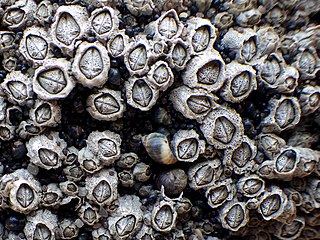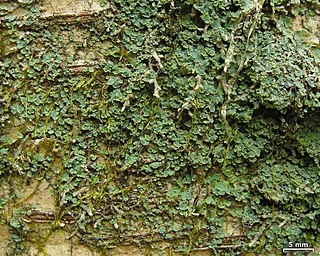| Ameson | |
|---|---|
| Scientific classification | |
| Kingdom: | Fungi |
| Phylum: | Rozellomycota |
| Class: | Microsporidea |
| Order: | Glugeida |
| Family: | Pereziidae |
| Genus: | Ameson Sprague 1977 |
Ameson is a genus of microsporidia belonging to the family Pereziidae. [1] [2]
| Ameson | |
|---|---|
| Scientific classification | |
| Kingdom: | Fungi |
| Phylum: | Rozellomycota |
| Class: | Microsporidea |
| Order: | Glugeida |
| Family: | Pereziidae |
| Genus: | Ameson Sprague 1977 |
Ameson is a genus of microsporidia belonging to the family Pereziidae. [1] [2]
Physcidia is a genus of lichen-forming fungi in the family Ramalinaceae. The genus was circumscribed in 1862 by American lichenologist Edward Tuckerman.
Clavascidium is a genus of lichens in the family Verrucariaceae. The genus was circumscribed in 1996 by Austrian lichenologist Othmar Breuss. Because the type species of the genus, Clavascidium umbrinum, has been shown using molecular phylogenetics to belong to genus Placidium, Cécile Gueidan and colleagues proposed to unite Clavascidium with Placidium in a 2009 publication. Despite this, the genus has been retained in recent publications of fungal classification.
Norrlinia is a genus of two species of fungi in the family Verrucariaceae. The genus was circumscribed by Ferdinand Theissen and Hans Sydow in 1918. The genus name honours the Finnish botanist Johan Petter Norrlin. Both species are lichenicolous, meaning they parasitise lichens. The host of both fungi is the foliose genus Peltigera.
Telogalla is a genus of lichenicolous fungi in the family Verrucariaceae. It has two species. The genus was circumscribed by Nikolaus Hoffmann and Josef Hafellner.
The Asterinaceae are a family of fungi in the monotypic class Asterinales.

Xanthopyreniaceae is a family of lichen-forming fungi in the order Collemopsidiales. The family was circumscribed by lichenologist Alexander Zahlbruckner in 1926.

Normandina is a genus of lichen-forming fungi in the family Verrucariaceae. It has three species:
Harpidium is a genus of lichen-forming fungi in the family Harpidiaceae. The genus contains three species. Harpidium was circumscribed in 1855 by German lichenologist Gustav Wilhelm Körber, with Harpidium rutilans assigned as the type species.
Leciophysma is a genus of cyanolichens in the family Pannariaceae. It has four species. The genus was circumscribed by Theodor Magnus Fries in 1865, with Leciophysma finmarkicum assigned as the type species.
Phragmocapnias is a genus of fungi in the family Capnodiaceae.
Nipholepis is a little-known fungal genus in the order Arthoniales. The genus has not been placed into a family. It is a monotypic genus, containing the single species Nipholepis filicina, found in Venezuela. Both the genus and species were described in 1935 by German mycologist Hans Sydow. Nipholepis filicina is an epiphytic fungus, living on the surface of plant leaves. Sydow found the fungus forming minute white flecks on the lower frond surfaces of the fern Diplazium expansum, the upper surface of which was covered in algae, mosses, and lichens. He noted a resemblance to the lichen Myxotheca hypocreoides, a member of the family Arthoniaceae.
The Cladochytriaceae are a family of fungi in the order Cladochytriales.

Baeomyces is a genus of lichenized fungi in the family Baeomycetaceae. Members of Baeomyces are commonly called cap lichens. The genus was circumscribed by German mycologist Christiaan Hendrik Persoon in 1794. Although Persoon did not designate a type species in his original description of the genus, Frederick Clements and Cornelius Lott Shear assigned Baeomyces byssoides as the type in 1931.

Mastodia is a genus of lichen-forming fungi in the family Verrucariaceae. It has six species. The genus was circumscribed in 1847 by Joseph Dalton Hooker and William Henry Harvey. The type species, Mastodia tessellata, is a bipolar, coastal lichen. It forms a symbiotic association with the macroscopic genus Prasiola; this is the only known lichen symbiosis involving a foliose green alga. Studies suggest that throughout its geographic range, the lichen comprises two fungal species and three algal lineages that associate.
Sporodictyon is a genus of crustose lichens in the family Verrucariaceae. It has 10 species. Most species grow on rocks, although some have been recorded overgrowing soil and mosses.
Collemopsidiales is an order of fungi in the class Dothideomycetes. First circumscribed by Sergio Pérez-Ortega, Isaac Garrido-Benavent and Martin Grube in 2016, it contains a single family, Xanthopyreniaceae.

Sarrameanaceae is a family of lichen-forming fungi in the monotypic order Sarrameanales. It contains two genera, Loxospora, and Sarrameana, the type genus. The family was circumscribed by Josef Hafellner in 1984. The order Sarrameanales was proposed by Brendan Hodkinson and James Lendemer in 2011, as they had noted that previously published large-scale molecular phylogenetic studies had shown that the group of species contained in the family Sarrameanaceae were distinct and separate from the clade containing all of the other orders of the Ostropomycetidae. However, the name Sarrameanales was not validly published according to the rules of botanical nomenclature, because it was not accompanied by a suitable description. Despite this, the order continues to be used in lichenological literature.
Thelenellaceae is a family of lichen-forming fungi. It is the sole family in the monotypic order Thelenellales, and contains three genera and about 50 species.
Austrographa is a genus of lichen-forming fungi in the family Roccellaceae. It has three species. The genus was circumscribed in 2013 by lichenologists Laurens Sparrius, John Elix, and Alan Archer, with Austrographa kurriminensis assigned as the type species. The genus had been published invalidly on two separate occasions. All three species in the genus were found in a mangrove stand in Queensland, Australia. The genus was discovered in Australia, and the name Austrographa reflects this.

Wetmoreana is a genus of lichen-forming fungi in the family Teloschistaceae. It has two crustose, saxicolous (rock-dwelling) species.